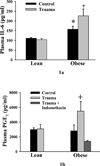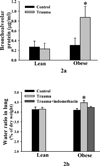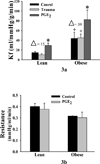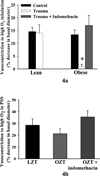Orthopedic trauma-induced pulmonary injury in the obese Zucker rat
- PMID: 21044219
- PMCID: PMC3270564
- DOI: 10.1111/j.1549-8719.2010.00061.x
Orthopedic trauma-induced pulmonary injury in the obese Zucker rat
Abstract
Objective: Obese subjects with orthopedic trauma exhibit increased inflammation and an increased risk of pulmonary edema. Prostaglandin E(2) (PGE(2) ) production is elevated during inflammation and associated with increased vascular permeability. We hypothesize that pulmonary edema in obesity following orthopedic trauma is due to elevated PGE(2) and resultant increases in pulmonary permeability.
Methods: Orthopedic trauma was induced in both hindlimbs in lean (LZ) and obese Zucker rats (OZ). On the following day, plasma interleukin-6 (IL-6) and PGE(2) levels, pulmonary edema, and pulmonary gas exchange capability were compared between groups: LZ, OZ, LZ with trauma (LZT), and OZ with trauma (OZT). Vascular permeability in isolated lungs was measured in LZ and OZ before and after application of PGE(2) .
Results: As compared with the other groups, the OZT exhibited elevated plasma IL-6 and PGE(2) levels, increased lung wet/dry weight ratio and bronchoalveolar protein concentration, and an impaired pulmonary gas exchange. Indomethacin treatment normalized plasma PGE(2) levels and pulmonary edema. Basal pulmonary permeability in isolated lungs was higher in OZ than LZ, with a further increase in permeability following treatment with PGE(2) .
Conclusions: These results suggest that pulmonary edema in OZ following orthopedic trauma is due to an elevated PGE(2) and resultant increases in pulmonary permeability.
© 2010 John Wiley & Sons Ltd.
Conflict of interest statement
We have no conflicts to disclose.
Figures




Similar articles
-
Inhibition of NADPH oxidase prevents acute lung injury in obese rats following severe trauma.Am J Physiol Heart Circ Physiol. 2014 Mar 1;306(5):H684-9. doi: 10.1152/ajpheart.00868.2013. Epub 2014 Jan 10. Am J Physiol Heart Circ Physiol. 2014. PMID: 24414071 Free PMC article.
-
β(2)-Adrenoreceptor blockade improves early posttrauma hyperglycemia and pulmonary injury in obese rats.Am J Physiol Heart Circ Physiol. 2014 Aug 15;307(4):H621-7. doi: 10.1152/ajpheart.00208.2014. Epub 2014 Jun 13. Am J Physiol Heart Circ Physiol. 2014. PMID: 24929860 Free PMC article.
-
Oxidative stress contributes to orthopedic trauma-induced acute kidney injury in obese rats.Am J Physiol Renal Physiol. 2015 Jan 15;308(2):F157-63. doi: 10.1152/ajprenal.00537.2014. Epub 2014 Nov 26. Am J Physiol Renal Physiol. 2015. PMID: 25428128 Free PMC article.
-
Pulmonary permeability oedema. Methods of estimation of pulmonary capillary permeability.Rocz Akad Med Bialymst. 1994;39:7-17. Rocz Akad Med Bialymst. 1994. PMID: 7497087 Review.
-
Ultrastructural abnormalities in increased-permeability pulmonary edema.Clin Chest Med. 1985 Sep;6(3):345-69. Clin Chest Med. 1985. PMID: 3907944 Review.
Cited by
-
Inhibition of NADPH oxidase prevents acute lung injury in obese rats following severe trauma.Am J Physiol Heart Circ Physiol. 2014 Mar 1;306(5):H684-9. doi: 10.1152/ajpheart.00868.2013. Epub 2014 Jan 10. Am J Physiol Heart Circ Physiol. 2014. PMID: 24414071 Free PMC article.
-
Distinct temporal phases of microvascular rarefaction in skeletal muscle of obese Zucker rats.Am J Physiol Heart Circ Physiol. 2014 Dec 15;307(12):H1714-28. doi: 10.1152/ajpheart.00605.2014. Epub 2014 Oct 10. Am J Physiol Heart Circ Physiol. 2014. PMID: 25305181 Free PMC article.
-
Early treatment with GLP-1 after severe trauma preserves renal function in obese Zucker rats.Am J Physiol Regul Integr Comp Physiol. 2019 May 1;316(5):R621-R627. doi: 10.1152/ajpregu.00312.2018. Epub 2019 Feb 27. Am J Physiol Regul Integr Comp Physiol. 2019. PMID: 30811247 Free PMC article.
-
Impact of the body mass on complications and outcome in multiple trauma patients: what does the weight weigh?Mediators Inflamm. 2013;2013:345702. doi: 10.1155/2013/345702. Epub 2013 Aug 19. Mediators Inflamm. 2013. PMID: 24023413 Free PMC article.
-
OBESITY AND CRITICAL ILLNESS: INSIGHTS FROM ANIMAL MODELS.Shock. 2016 Apr;45(4):349-58. doi: 10.1097/SHK.0000000000000512. Shock. 2016. PMID: 26513706 Free PMC article. Review.
References
-
- Adkins WK, Barnard JW, May S, Seibert AF, Haynes J, Taylor AE. Compounds that increase cAMP prevent ischemia-reperfusion pulmonary capillary injury. J Appl Physiol. 1992;72(2):492–497. - PubMed
-
- Bakhle YS, Grantham CJ. Selective effect of pulmonary oedema on prostaglandin E2 pharmacokinetics in rat lung. Biochem Pharmacol. 15. 1985;34(24):4325–4327. - PubMed
-
- Belzberg H, Wo CC, Demetriades D, Shoemaker WC. Effects of age and obesity on hemodynamics, tissue oxygenation, and outcome after trauma. J Trauma. 2007;62(5):1192–1200. - PubMed
-
- Bischoff A, Limmroth V, Michel MC. Indomethacin inhibits the natriuretic effects of neuropeptide Y in anesthetized rats. J Pharmacol Exp Ther. 1998;286(2):704–708. - PubMed
-
- Bone RC. Toward a theory regarding the pathogenesis of the systemic inflammatory response syndrome: what we do and do not know about cytokine regulation. Crit Care Med. 1996;24(1):163–172. - PubMed
Publication types
MeSH terms
Substances
Grants and funding
LinkOut - more resources
Full Text Sources
Medical
Research Materials

